THE SKYRANGER DRONE TAKES HIGH-RESOLUTION IMAGES
The inspection of critical infrastructure, such pipelines, railroads and power lines, is falling more and more on the shoulders of unmanned flying drones as federal regulations allow, and Addison-based Aviation Unmanned is leading that charge.
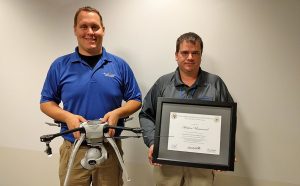
Ryan Connelly and Kory Ferguson show off the Aviation Unmanned drone,the Skyranger, and the certificate from the Texas A&M Engineering Extension Service. (Photo by Nicholas Sakelaris)
Aviation Unmanned, has 50 employees and a fleet of five drones. The company is one of two in Texas to receive official credentials from the Texas A&M Engineering Extension Service (TEEX).
The credential establishes Aviation Unmanned as meeting the highest standard for training and safety for operating drones.
Aviation Unmanned employs military veterans with years of experience as pilots of real aircraft and drones. Charles Winfree, senior manager of commercial operations, said this separates Aviation Unmanned from the “mom and pop hobby shops.”
“When you look at the clients that we deal with, they cannot afford for you to create problems,” Winfree said. “A stoppage is not an option because it would cost them an absolute fortune.”
AVIATION UNMANNED’S SKYRANGER DRONE CAN FIT IN A SUITCASE
The Aeryon Skyranger is small and agile, about 40 inches long when deployed, and weighs about 5 pounds without the payload, or camera, attached. It even folds down to about 9 inches so it can fit into a suitcase for easy travel on commercial aircraft.
But don’t let the size fool you.
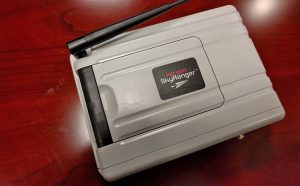
The transmitter that communicates with the drone. (Photo by Nicholas Sakelaris)
This drone can shoot high resolution photos and video that’s detailed enough to show cracks in a weld on a refinery smokestack, or problems at the top of a power pole or wind turbine. Each one costs more than $100,000. It can hover in 40 mph winds or even 55 mph gusts, just the type of weather it could encounter while inspecting downed power lines after a hurricane blows through. It can fly for 50 minutes and carry a variety of high-tech, and expensive, cameras.
“We can get them absolute detail before any guy has to climb that pole,” Winfree said. “The idea is cost savings. It’s not only a cost savings but it’s also a safety issue.”
And, because it flies next to such expensive equipment, Aviation Unmanned carries $20 million worth of insurance on the drone.
Centerpoint Energy, the electric utility in Houston, recently hired Aviation Unmanned to inspect power lines near Bush Intercontinental Airport. Winfree said they filed a waiver with the Federal Aviation Administration so all pilots flying into Bush would be aware that drones would be flying in the airspace.
The company uses a two-man crew. There’s the operator, who controls the drone using a flatscreen tablet-like device, and a visual observer who keeps an eye on the drone.
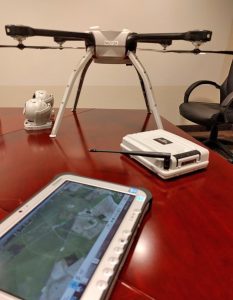
The drone, touchscreen and transmitter for the Skyranger. (Photo by Nicholas Sakelaris)
SPECIAL DELIVERY BY DRONE?
Amazon CEO Jeff Bezos has been on a crusade to change FAA regulations so that he can use drones to deliver packages. Called Amazon Prime Air, the program would deliver packages weighing less than 5 pounds within 30 minutes. Read more about that here.
Winfree said Aviation Unmanned has all the work it can handle doing inspections and emergency response, so it won’t be messing with package delivery, real estate tours, or roof inspections. All those applications still need to navigate a tangled web of legal hurdles.
“The [unmanned aerial system] needs to be incorporated into the national airspace system in a safe manner,” Winfree said. “It’s not our target market. We don’t really care about delivering packages. If you try to be everything to everybody, I think you fail miserably.”
And, he said, the FAA has a long way to go before allowing drones to fly over neighborhoods. The permitting process could cost Amazon and others millions of dollars and for good reason—even a small drone can damage an airliner if it hits in the right spot.
“We are always a little suspect when the regulations get a little lax,” he said.
For a daily dose of what’s new and next in Dallas-Fort Worth innovation, subscribe to our Dallas Innovates e-newsletter.










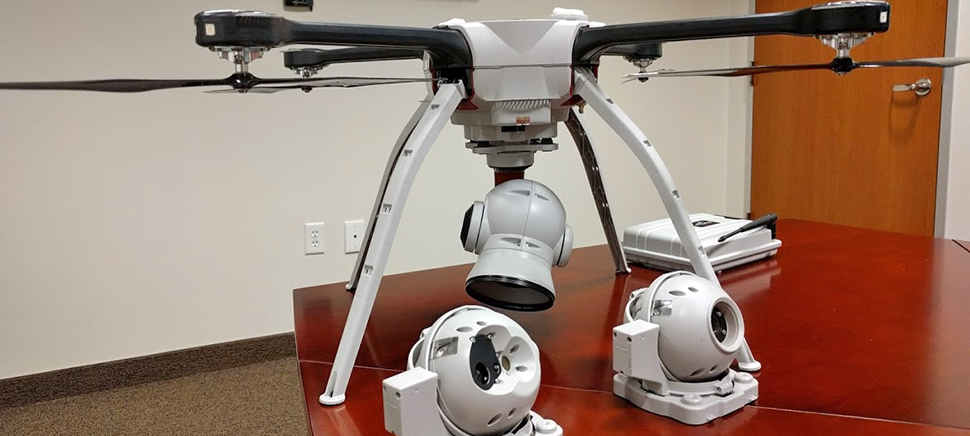
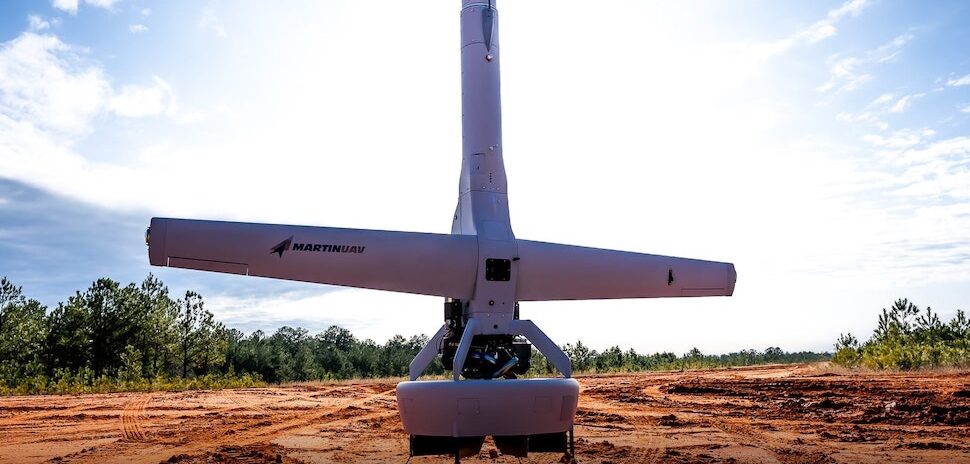
![A NASA illustration depicts the idea of a future air taxi hovering over a municipal vertiport. [Rendering: NASA/Lillian Gipson and Kyle Jenkins]](https://s24806.pcdn.co/wp-content/uploads/2021/06/DRC-NTCOG-NASA-970-970x464.jpg)


















































